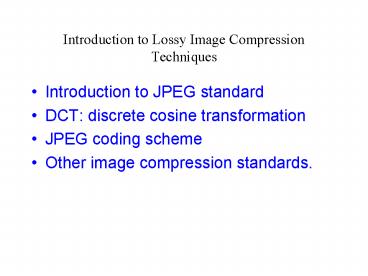Introduction to Lossy Image Compression Techniques - PowerPoint PPT Presentation
1 / 22
Title:
Introduction to Lossy Image Compression Techniques
Description:
Zig-zag ordering and run-length encoding. Entropy coding. ... run of zeros: a zig-zag scan is used to turn ... The Zig-zag scan process. DPCM on DC coefficients ... – PowerPoint PPT presentation
Number of Views:379
Avg rating:3.0/5.0
Title: Introduction to Lossy Image Compression Techniques
1
Introduction to Lossy Image Compression
Techniques
- Introduction to JPEG standard
- DCT discrete cosine transformation
- JPEG coding scheme
- Other image compression standards.
2
JPEG
- 1. JPEG is an image compression standard that was
developed by the Joint Photographic Experts
Group". JPEG was formally accepted as an
international standard in 1992. - 2. JPEG is a lossy image compression method. It
employs a transform coding method using the DCT
(Discrete Cosine Transform). - An image is a function of i and j (or
conventionally x and y) in the spatial domain.
The 2D DCT is used as one step in JPEG in order
to yield a frequency response which is a function
F(u v) in the spatial frequency domain, indexed
by two integers u and v.
3
Several observations of JPEG and DCT
- Observation 1 Useful image contents change
relatively slowly across the image, i.e., it is
unusual for intensity values to vary widely
several times in a small area, for example,
within an 8x8 image block. - much of the information in an image is repeated,
hence spatial redundancy".
4
Several observations of JPEG and DCT (cont.)
- Observation 2 Psychophysical experiments
suggest that humans are much less likely to
notice the loss of very high spatial frequency
components than the loss of lower frequency
components. - The spatial redundancy can be reduced by largely
reducing the high spatial frequency contents.
5
Several observations of JPEG and DCT (cont.)
- Observation 3 Visual acuity (accuracy in
distinguishing closely spaced lines) is much
greater for gray (black and white") than - for color.
- chroma subsampling (420) is used in JPEG.
6
JPEG image compression process
7
Main Steps in JPEG image compression process
- Transform RGB to YIQ or YUV and subsample color.
- DCT on image blocks.
- Quantization.
- Zig-zag ordering and run-length encoding.
- Entropy coding.
8
DCT on image blocks
- Each image is divided into 8 8 blocks. The 2D
DCT is applied to each block image f(i, j), with
output being the DCT coefficients F(u v) for
each block. - Using blocks, however, has the effect of
isolating each block from its neighboring
context. This is why JPEG images look choppy
(blocky") when a high compression ratio is
specified by the user.
9
Definition of Discrete Cosine Transform
where
FDCT forward DCT IDCT inverse DCT
10
Quantization
- F(u v) represents a DCT coefficient, Q(u v) is
a quantization matrix" entry, and
represents the quantized DCT coefficients
which JPEG will use in the succeeding entropy
coding. - The quantization step is the main source for
image quality loss and data reduction in JPEG
compression.
11
- The quantization is not uniform. This aims to
introduce more loss at the higher spatial
frequencies -- a practice supported by
Observations 1 and 2. - The quantization is different for luminance and
chrominance (YUV components). Table 9.1 and 9.2
show the default Q(u v) values obtained from
psychophysical studies with the goal of
maximizing the compression ratio while minimizing
perceptual losses in JPEG images.
12
JPEG Quantization Tables
13
One example of Quantization process
14
(No Transcript)
15
The error of compression
16
Run-length Coding (RLC) on AC coefficients
RLC aims to turn the quntized F(u v) values into
sets of zeros-to-skip , next non-zero value.
To make it most likely to hit a long run of
zeros a zig-zag scan is used to turn the 8x8
matrix of encoded F(u v) into a 64-vector.
17
The Zig-zag scan process
18
DPCM on DC coefficients
The DC coefficients are coded separately from the
AC ones.Differential Pulse Code Modulation (DPCM)
is the coding method. Suppose the DC
coefficients for the first 5 image blocks are
150, 155, 149, 152, 144, then the DPCM would
produce 150, 5, -6, 3, -8, assuming the
prediction model of e(i) d(i)-d(i-1).
19
Entropy Coding
The DC and AC coefficients finally undergo an
entropy coding step to gain a possible further
compression. Use DC as an example each DPCM
coded DC coefficient is represented by (SIZE,
AMPLITUDE), where SIZE indicates how many bits
are needed for representing the coefficient, and
AMPLITUDE contains the actual bits. In the
example we're using, codes 150, 5, -6, 3, -8 will
be turned into (8, 10010110), (3, 101), (3, 001),
(2, 11), (4, 0111) . SIZE is Human coded since
smaller SIZEs occur much more often. AMPLITUDE is
not Human coded, its value can change widely so
Human coding has no appreciable benefit.
20
JPEG Bit stream
21
Intro to JPEG 200 Standard
Design Goals To provide a better rate-distortion
tradeoff and improved subjective image
quality. To provide additional functionalities
lacking in the current JPEG standard.
22
Region of Interest coding in JPEG 200 Standard































